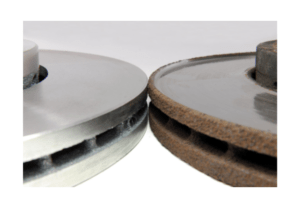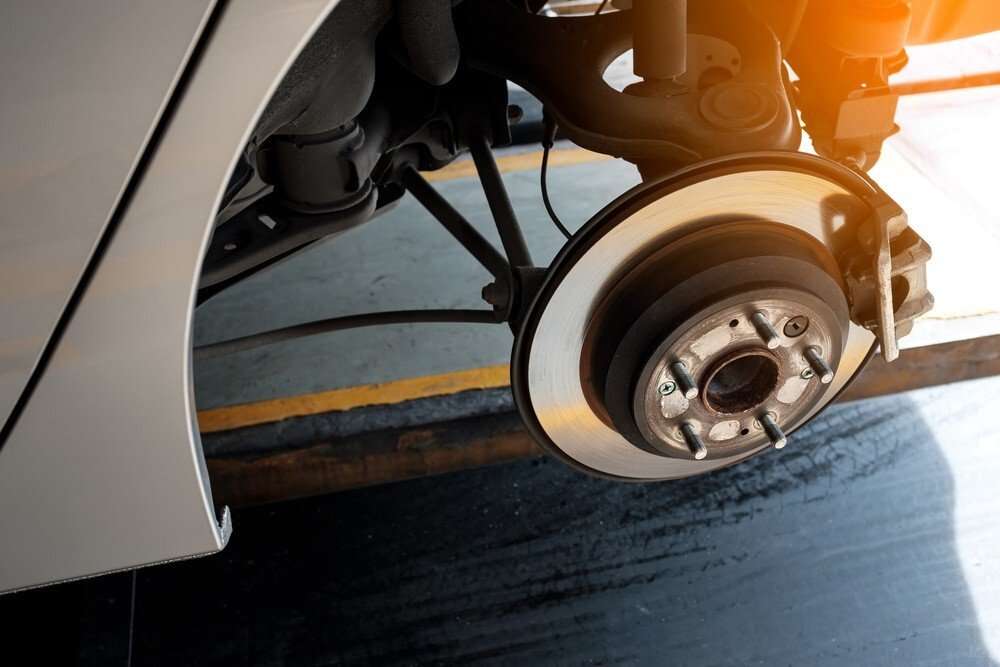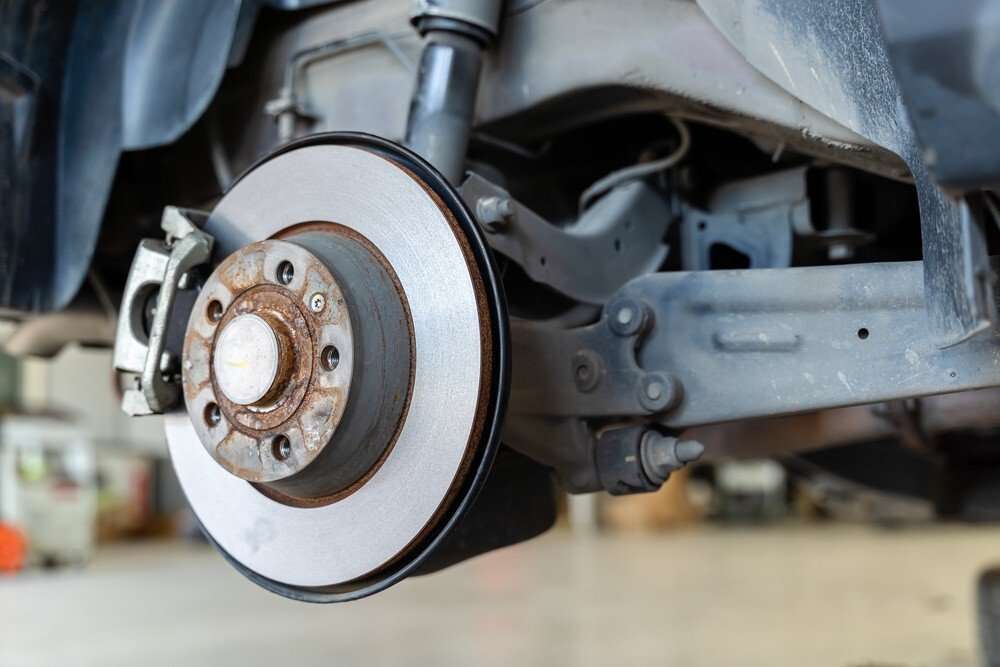Your brake rotors are part of your vehicle’s braking system. Many people don’t know how long the rotors on their vehicle last, or even know what a brake rotor is. Your brake rotor is a thick metal disc that sits between your brake pads and wheel. The rotor works to slow the rotation of the wheels by friction with the brake pads when you press the brake pedal. Learn what is the average lifetime of brake rotors and how to extend the lifetime in the following article.
There are many factors such as the make, model, and even the style of your car or truck. That can affect the lifespan of your brake parts such as driving style, driving conditions, vehicle type, and even where you live. This information should give you a basic idea of what to expect regarding wear and tear and when you should schedule a replacement of rotors and brake pads.
Your brake rotors will eventually experience wear and tear, meaning they will have used up all their metal. That’s why it’s so important to know what is the average lifetime of brake rotors so that you can stay ahead of maintaining your vehicle, without paying too much. You should also look at how your brake pads wear.
Jump to
What Are Brake Rotors

Brake rotors, also known as brake discs, are a crucial component of a vehicle’s braking system. They play a critical role in the safe operation of a vehicle by converting the kinetic energy of the moving vehicle into heat energy, which is dissipated into the surrounding environment. Brake rotors are found on all types of vehicles, including cars, trucks, and motorcycles, and come in a variety of sizes and materials.
One of the primary purposes of brake rotors is to provide a surface for the brake pads to grip onto when stopping a vehicle. When the brake pedal is depressed the brake pads squeeze against the brake rotors or brake disc, friction is generated, which slows down the rotation of the wheels and brings the vehicle to a stop. Brake rotors are designed to handle high levels of heat and stress, as well as constant wear and tear from repeated use.
Brake rotors can be made from a variety of materials, including cast iron, steel, and ceramic. Cast iron brake rotors are the most common and are typically used on passenger cars and light trucks. They are relatively inexpensive and can handle a wide range of driving conditions. Steel brake rotors are often used on high-performance vehicles and can provide better heat dissipation and durability than cast iron. Ceramic brake rotors are the most expensive option but offer the best performance, particularly in high-speed driving and racing applications.
There are several different types of brake rotors available, each with its own set of benefits and drawbacks. Standard brake rotors are the most common and are suitable for everyday driving. Slotted brake rotors have slots cut into them to help dissipate heat and gas buildup, which can improve braking performance in certain situations. Cross-drilled brake rotors have holes drilled into them to allow for better cooling and to reduce the buildup of brake dust. However, cross-drilled rotors can be prone to cracking and are not recommended for extreme driving conditions.
When choosing new brake rotors for a vehicle, it’s important to consider the driving conditions and intended use of the vehicle. For everyday driving, standard brake rotors are typically sufficient. However, for high-performance applications or extreme driving conditions, slotted or cross-drilled brake rotors may be necessary. It’s also important to choose brake rotors that are compatible with the vehicle’s brake pads and calipers.
Proper maintenance and care of brake rotors are essential for ensuring safe and reliable vehicle operation of your braking system. Regular inspections of the brake rotors and brake pads can help identify any issues before they become serious problems. The brake disc should be replaced with new brake rotors and brake pads when they become worn or damaged, and it’s important to follow the manufacturer’s recommended replacement intervals.
What is the Average Lifetime of Brake Rotors
The average lifetime of brake rotors is 25,000 to 50,000 miles depending on driving habits and the weather. Let’s talk about how the average lifetime of your brakes can affect your safety as well as the safety of other drivers on the road.
There is not any exact time for the life span of brake rotors, but rotors wear out over time. Here are some signs and recommendations through which you will be clear about the average lifetime of brake rotors.
- If you are driving in an urban area with a lot of stop-and-go traffic, your brake rotors and brake pads wear out faster than if you are living in a rural area or driving on highways. Plus, vehicles that are made for extreme performance also need special brake rotors because they put a lot of stress on the parts.
- Most vehicles have disc brake rotors, but some trucks and most performance cars use a different type called drilled disc brakes. Most vehicle manufacturers recommend replacing your brake rotors at least once every 25-40 thousand miles or about once every four years. This is just for normal driving conditions. If you do a lot of driving in extreme temperatures or additional stress on your brake system, you’ll need to replace them sooner.
- If you have drilled disc brakes, you will be able to get up to 2-3 times the life of normal discs if you’re only driving around town and not doing a lot of extra stress on your brakes. If you are driving these vehicles on a daily basis and doing stop-and-go traffic from areas with heavy rains, snow, or just extreme temperatures, you should replace them about every 12-15 thousand miles.
- Also, if you take your vehicle off-road, the surface that you are driving on can have an effect on how long your rotors and brake pads last.
- If you start noticing a vibrating in your brake pedal or squeaking while braking from the worn-out rotor, it’s time to get them replaced. The faster that you replace your rotors when you first notice the problem, the less chance you have of doing serious damage to your brake system.
- If you have drilled disc brakes, an easy way to check if they need replacement is to look at the warranty sticker (or ask your mechanic). These stickers will tell you what the lifetime of the brakes should be for normal driving conditions. If you are not performing these types of driving habits, you probably won’t need to change your rotors as often (but it’s always best to check with a mechanic just to make sure).
- When replacing your brake rotors, it’s a good idea to replace both sides at the same time and make sure you use rotors that are made for your vehicle. If not, you might experience uneven rotor wear, brake noise, or even brake failure.
How to Extend the Lifetime of Brake Rotors?

Here are some universal tips and suggestions to increase the lifetime of brake rotors:
- Be mindful of the weather and road conditions that you drive through. That includes stopping distance, and braking response time, whether you are in an area with a lot of rain or snow or if you live in a room with extreme temperatures.
- Avoid driving on extremely rough surfaces, speed bumps, or areas where lots of heavy trucks are driving. This can be detrimental to your brakes and rotors.
- Make sure you change the type of brake pads that you use as well (if you are using any). This will help extend the life of your brake rotors because they will have more surface area on your brake pads to grip onto, meaning less stress from the rotor itself.
- If your brake rotors are worn down to the point where they need replacement, it’s also a good idea to inspect your calipers and brake lines in case you need to have them replaced as well. This will help clean out any corrosion or rust from your brakes that could cause additional stress on your rotors when you start driving again. (For more information about calipers and brake lines, check out this article on fixing your brakes.
- The more frequently you stop and go, the faster your brake rotors will wear down. Even if you perform these types of driving habits, it would be in your best interests to replace them every 6-12 thousand miles or as needed.
- Inspect your rotors before replacing them to make sure they are not cracked or warped. This can put additional stress on your brake system and cause them to wear down faster than they would normally.
- Finally, always follow the guidelines of your vehicle’s manufacturer when it comes to routine maintenance and replacement parts. This will ensure that you have peace of mind knowing that the equipment is up to par with industry standards. (For more information about.
Note: If you are experiencing issues with your brake rotors and brake pads, make sure that you have them inspected and replaced right away. Otherwise, you could end up with additional problems or worse serious injury or death from an accident.
Final Thoughts
In conclusion, the best advice you can get is to be mindful of how much and what type of driving you are doing when it comes to your brake rotors and brake pads. This will determine how often they need routine maintenance or replacement.
If you feel any signs of vibration in the steering wheel or brake pedal while braking, squeaking noises, or if your vehicle is pulling to one side when you brake, it’s probably time for a replacement. The faster that you replace the rotors and brake pads when you first notice the problem, the less chance you have of doing serious damage to your entire braking system.

My name is Tom Harris, founder of this blog. I’m a mechanical engineer with 20 years of experience in the automotive industry. I’m here to help you with your vehicle’s problems, easy fixes and share my insights and experience so that you can enjoy your rides more.

